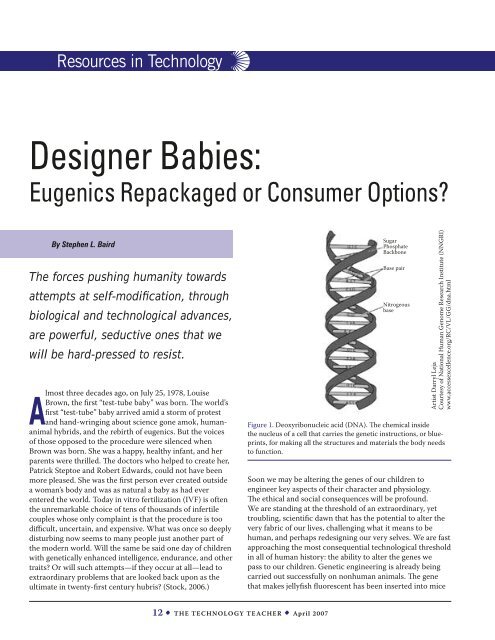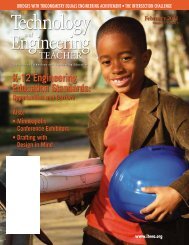Vol 66, No. 7 - International Technology and Engineering Educators ...
Vol 66, No. 7 - International Technology and Engineering Educators ...
Vol 66, No. 7 - International Technology and Engineering Educators ...
You also want an ePaper? Increase the reach of your titles
YUMPU automatically turns print PDFs into web optimized ePapers that Google loves.
Resources in <strong>Technology</strong><br />
Designer Babies:<br />
Eugenics Repackaged or Consumer Options?<br />
By Stephen L. Baird<br />
The forces pushing humanity towards<br />
attempts at self-modification, through<br />
biological <strong>and</strong> technological advances,<br />
are powerful, seductive ones that we<br />
will be hard-pressed to resist.<br />
lmost three decades ago, on July 25, 1978, Louise<br />
A<br />
Brown, the first “test-tube baby” was born. The world’s<br />
first “test-tube” baby arrived amid a storm of protest<br />
<strong>and</strong> h<strong>and</strong>-wringing about science gone amok, humananimal<br />
hybrids, <strong>and</strong> the rebirth of eugenics. But the voices<br />
of those opposed to the procedure were silenced when<br />
Brown was born. She was a happy, healthy infant, <strong>and</strong> her<br />
parents were thrilled. The doctors who helped to create her,<br />
Patrick Steptoe <strong>and</strong> Robert Edwards, could not have been<br />
more pleased. She was the first person ever created outside<br />
a woman’s body <strong>and</strong> was as natural a baby as had ever<br />
entered the world. Today in vitro fertilization (IVF) is often<br />
the unremarkable choice of tens of thous<strong>and</strong>s of infertile<br />
couples whose only complaint is that the procedure is too<br />
difficult, uncertain, <strong>and</strong> expensive. What was once so deeply<br />
disturbing now seems to many people just another part of<br />
the modern world. Will the same be said one day of children<br />
with genetically enhanced intelligence, endurance, <strong>and</strong> other<br />
traits? Or will such attempts—if they occur at all—lead to<br />
extraordinary problems that are looked back upon as the<br />
ultimate in twenty-first century hubris? (Stock, 2006.)<br />
Sugar<br />
Phosphate<br />
Backbone<br />
Base pair<br />
Nitrogeous<br />
base<br />
Artist Darryl Leja<br />
Courtesy of National Human Genome Research Institute (NNGRI)<br />
www.accessexcellence.org/RC/VL/GG/dna.html<br />
Figure 1. Deoxyribonucleic acid (DNA). The chemical inside<br />
the nucleus of a cell that carries the genetic instructions, or blueprints,<br />
for making all the structures <strong>and</strong> materials the body needs<br />
to function.<br />
Soon we may be altering the genes of our children to<br />
engineer key aspects of their character <strong>and</strong> physiology.<br />
The ethical <strong>and</strong> social consequences will be profound.<br />
We are st<strong>and</strong>ing at the threshold of an extraordinary, yet<br />
troubling, scientific dawn that has the potential to alter the<br />
very fabric of our lives, challenging what it means to be<br />
human, <strong>and</strong> perhaps redesigning our very selves. We are fast<br />
approaching the most consequential technological threshold<br />
in all of human history: the ability to alter the genes we<br />
pass to our children. Genetic engineering is already being<br />
carried out successfully on nonhuman animals. The gene<br />
that makes jellyfish fluorescent has been inserted into mice<br />
12 • The <strong>Technology</strong> Teacher • April 2007
















